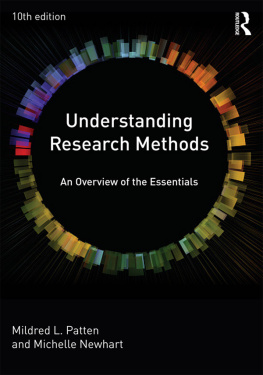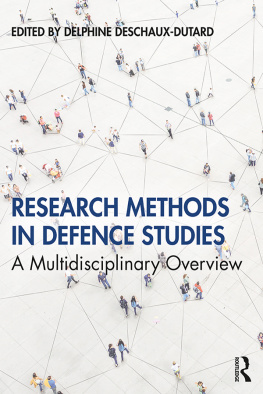Newhart Michelle - Understanding research methods: an overview of the essentials
Here you can read online Newhart Michelle - Understanding research methods: an overview of the essentials full text of the book (entire story) in english for free. Download pdf and epub, get meaning, cover and reviews about this ebook. City: London;New York, year: 2018, publisher: Taylor & Francis Ltd;Routledge, genre: Children. Description of the work, (preface) as well as reviews are available. Best literature library LitArk.com created for fans of good reading and offers a wide selection of genres:
Romance novel
Science fiction
Adventure
Detective
Science
History
Home and family
Prose
Art
Politics
Computer
Non-fiction
Religion
Business
Children
Humor
Choose a favorite category and find really read worthwhile books. Enjoy immersion in the world of imagination, feel the emotions of the characters or learn something new for yourself, make an fascinating discovery.
- Book:Understanding research methods: an overview of the essentials
- Author:
- Publisher:Taylor & Francis Ltd;Routledge
- Genre:
- Year:2018
- City:London;New York
- Rating:3 / 5
- Favourites:Add to favourites
- Your mark:
- 60
- 1
- 2
- 3
- 4
- 5
Understanding research methods: an overview of the essentials: summary, description and annotation
We offer to read an annotation, description, summary or preface (depends on what the author of the book "Understanding research methods: an overview of the essentials" wrote himself). If you haven't found the necessary information about the book — write in the comments, we will try to find it.
Understanding research methods: an overview of the essentials — read online for free the complete book (whole text) full work
Below is the text of the book, divided by pages. System saving the place of the last page read, allows you to conveniently read the book "Understanding research methods: an overview of the essentials" online for free, without having to search again every time where you left off. Put a bookmark, and you can go to the page where you finished reading at any time.
Font size:
Interval:
Bookmark:
Introduction to Effect Size ( d )
The magnitude (i.e., size) of a difference when it is expressed on a standardized scale is referred to as the effect size . The statistic d is one of the most popular for describing the effect size of the difference between two means. To understand the need to consider the effect size of a difference, consider a practical problem in interpreting two sets of research findings that can be resolved using the statistic d .
Suppose that Experimenter A administered a new treatment for depression (Treatment X) to an experimental group, while the control group received a standard treatment. Furthermore, suppose that Experimenter A used a 20-item true-false depression scale (with possible raw scores from 0 to 20) and on the posttest obtained the results shown in Note that the difference between the two means is 5 raw-score points.
Now suppose that Experimenter B administered Treatment Y to an experimental group while treating the control group with the standard treatment. Furthermore, suppose Experimenter B used a 30-item scale with choices from strongly agree to strongly disagree (with possible scores from 0 to 120) and obtained the results in , which show a difference of 10 raw-score points in favor of the experimental group.
Which treatment is superior? Treatment X, which resulted in a 5-point raw-score difference between the two means, or Treatment Y, which resulted in a 10-point raw-score difference between the two means? The answer is not clear because the two experimenters used different measurement scales (0 to 20 versus 0 to 120).
Statistics Obtained in Experiment A (Treatment X)
| Group | m | sd |
| Experimental group (n = 50) | 12.00 | 4.00 |
| Control group (n = 50) | 7.00 | 4.00 |
| Difference between two means | 5.00 |
Statistics Obtained in Experiment B (Treatment Y)
| Group | m | sd |
| Experimental group (n = 50) | 80.00 | 14.00 |
| Control group ( n = 50) | 70.00 | 14.00 |
| Difference between two means | 10.00 |
Differences Expressed in Raw Scores and Values of d
| Group | Raw-score differences | Standardized differences (d) |
| Experimenter A | 5 points | 1.25 |
| Experimenter B | 10 points | 0.71 |
For the results of the two studies to be comparable, they need to be standardized so that both differences can be expressed on the same scale. The most straightforward way to do this is to express both differences in terms of standard-deviation units (instead of raw-score units). In Experiment A, one standard-deviation unit equals 4.00 raw-score points. The formula below shows how d is obtained. In this formula, m e stands for the mean of the experimental group, and m c stands for the mean of the control group. The difference between the means (5.00) is divided by the standard-deviation unit for Experiment A (4.00 points). This yields an answer of 1.25:
| d=memcsd=12.007.004.00=1.25 |
The result indicates that the experimental group exceeded the control group by 1.25 standard-deviation units. For all practical purposes, there are only three standard-deviation units on each side of the mean, or the center of the normal distribution graph. Thus, d is expressed in standard-deviation units and has an effective range from 0.00 (no difference between the means) to 3.00. For Experiment A, the experimental group is 1.25 standard deviations from the central value (0.00) on a standardized scale that ranges from 0.00 to 3.00. As you may recall, being between 1 and 2 standard deviations means that the value is not in the middle 68% but is between 68% and 95% of all values.
Using the formula for Experiment B, the difference in means (5.00) is divided by the standard deviation (10.00/14.00), yielding d = 0.71, which is almost three-quarters of the way above 0.00 on the three-point scale. Now we can compare the two experiments on a common (i.e., standardized) scale called d . Clearly, the difference in Experiment A (1.25) is greater than the difference in Experiment B (0.71).
summarizes the differences. Remember that the two raw-score differences are not directly comparable because different measurement scales were used (0 to 20 points versus 0 to 120 points). By examining the standardized values of d , a meaningful comparison of the results of the two experiments can be made.
Within each of the two examples in this topic, the two standard deviations are equal. When they are unequal, a special averaging procedure that results in a pooled standard deviation should be used. In the next topic, the interpretation of d is discussed in more detail. In , an alternative statistic for expressing effect size is described.
- In this topic, which experimenter had the smaller range of possible raw scores? Explain.
- In this topic, the raw-score differences between the means (5 for Experimenter A and 10 for Experimenter B) were standardized by dividing each of them by what statistic?
- When comparing the results of two experiments, is it possible for the experiment with the smaller raw-score difference to have a larger difference when the differences are expressed as d ?
- Suppose a researcher obtained a value of d of 2.95. Should this be characterized as representing a large difference? Explain.
- Suppose you read that the mean for an experimental group is 20.00 and the mean for the control group is 22.00. On the basis of this information alone, can you calculate the value of d ? Explain.
- Suppose a researcher conducted an experiment on improving algebra achievement, and the experimental posttest raw-score mean equaled 500.00 ( sd = 100.00), and the control group raw-score mean equaled 400.00 ( sd = 100.00). What is the value of the effect size for the experiment?
- What is the definition of effect size ?
- In your own words, briefly explain why it is desirable to compute d when comparing the results of two experiments that use different measurement scales.
Do you plan to report value(s) of d in the Results section of your research report? How will you use it?
Note that in the experiments in this topic, the researchers used measures that yield higher scores when there is less depression.
See Topic 63 to review the meaning of the standard deviation.
If a control group has a higher mean than the experimental group, the value of d will be negative.
One-Way Analysis of Variance (F)
as well as degrees of freedom ( df ), sum of squares, mean square, and a p value, which indicates the probability that the null hypothesis is correct. As with the t -test, the only value of interest to the typical consumer of research is the value of p . By convention, when p equals.05 or less (such as.01 or.001), researchers reject the null hypothesis and declare the result to be statistically significant.
Because the t -test and ANOVA are based on the same theory and assumptions, when two means are compared, both tests yield exactly the same value of p and, hence, lead to the same conclusion regarding significance. Thus, for two means, both tests are equivalent. Note, however, that a single t -test can compare only two means, but a single ANOVA can compare a number of means, which is a great advantage.
Suppose, for example, a researcher administered three drugs designed to treat depression in an experiment and obtained the means in , in which the higher the score, the greater the depression.
Font size:
Interval:
Bookmark:
Similar books «Understanding research methods: an overview of the essentials»
Look at similar books to Understanding research methods: an overview of the essentials. We have selected literature similar in name and meaning in the hope of providing readers with more options to find new, interesting, not yet read works.
Discussion, reviews of the book Understanding research methods: an overview of the essentials and just readers' own opinions. Leave your comments, write what you think about the work, its meaning or the main characters. Specify what exactly you liked and what you didn't like, and why you think so.










